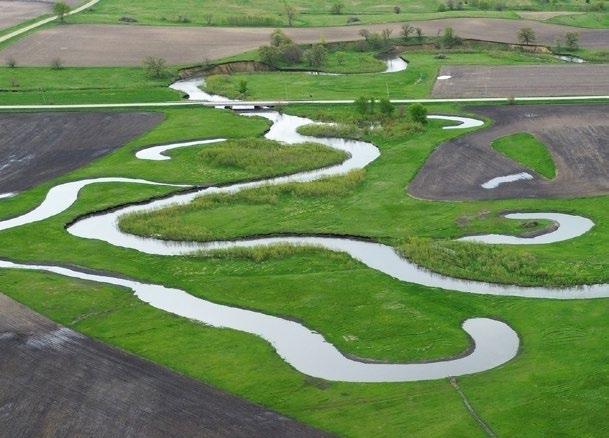
5 minute read
Approaching the Field Edge Differently
Approaching the Field Edge Differently
By Mike Gilman, mgilman@iasoybeans.com
Key Insights
Edge-of-field practices like bioreactors, saturated buffers and restored oxbows are effective tools for reducing nitrate runoff (35–60%) and improving water quality, while also benefiting wildlife habitats.
The batch and build model boosts efficiency and affordability by targeting high-impact sites, streamlining the process and reducing costs through grouped installations and strong partnerships.
Funding is available to help farmers and landowners implement these practices.
Iowa farmers and conservation professionals have worked together for many years to improve water quality across the state. One of the most promising approaches has been the implementation of edge-of-field practices, which intercept and treat water leaving agricultural fields, and before the water has the potential to affect streams, rivers and drinking water sources.
Among the most effective tools in this strategy are bioreactors, saturated buffers and restored oxbows. While these methods are scientifically proven and widely adaptable, they are not simple plug-and-play solutions. However, recent innovations in how these projects are deployed — especially through the "Batch and Build" model — have significantly increased their efficiency and affordability.
Bioreactors: a natural filter
Bioreactors are underground systems designed to reduce nitrate levels in tile-drained water. They work by rerouting water through a buried trench filled with a carbon source, typically woodchips. As water flows through, beneficial microorganisms feed on the nitrate, converting it into harmless nitrogen gas that's released into the atmosphere.
Key elements of bioreactors include:
Nitrate reduction: 35–50%
Installation: Typically placed on the edges of fields in grassed areas, such as CRP land, usually around or less than 3,000 square feet
Benefits: Small installation area typically in set-aside areas
Cost: $7,000–$12,000
Saturated buffers: harnessing nature
Saturated buffers use a different but equally effective approach. Tile water is diverted into perforated pipes installed beneath grassed buffer zones. As the water saturates the surrounding soil, plants and microbes absorb nutrients, preventing them from flowing into nearby waterways.
Key elements of saturated buffers include:
Nitrate reduction: 35-50%
Installation: Typically placed in existing buffer strips utilizing 300-400 feet of perforated tile
Benefits: Uses existing grassed buffer areas or low production acres
Cost: $5,000–$7,000
Restored oxbows
Restored oxbows make use of past stream and river bends that have been closed off from the main waterway to slow and filter water leaving fields through tile drainage. This allows nutrients, sediment and potentially harmful chemicals to settle out and be removed while also providing habitat for many aquatic and amphibian species.
Key elements of restored oxbows include:
Nitrate reduction: 60%
Installation: Typically installed near rivers or streams where previous natural oxbows have been closed off
Benefits: Water quality and habitat improvements
Cost: Average $16,000, but varies by size and obstacles
Smarter planning with modern tools
Today's edge-of-field conservation doesn't start in the soil, it starts with data. Most projects begin by identifying high-priority areas using the Agricultural Conservation Planning Framework (ACPF). This GIS-based tool helps coordinators map potential sites for bioreactors and buffers.
However, technology is just the starting point. After mapping, coordinators hit the road for visual surveys, looking for ideal slopes, tile outlets and suitable edge-of-field zones. Once promising sites are identified, the next step is connecting with landowners to discuss the benefits and logistics of installation.
Batch and Build model
One of Iowa's most successful and the first implementation of this model took place in Polk County, where a team installed 136 edge-of-field practices in two years. This success story became proof of concept for the Batch and Build model across the state.
Key elements of the batch and build model:
Strategic targeting: Focused on high-potential sites using tools like ACPF
Streamlined process: Simplified applications and funding coordination
Lower costs: Contractors were more willing to bid on grouped projects, reducing mobilization expenses
Collaboration: Strong partnerships between coordinators, landowners, contractors and government agencies
Thanks to this model, organizations like the Iowa Soybean Association (ISA) are now leading similar projects statewide such as the Farm to River Partnership Project, Iowa Partners for Conservation and the Benton County Batch and Build project. In many cases these structures can be offered at a low cost or no cost to farmers and landowners.
ISA conservation professionals are expanding conservation implementation. Since January 2025, ISA has worked with nearly 75 landowners to implement edge-of-field practices across the state. In addition to this work, ISA has two Batch and Build projects currently underway in the Farm to River area, working to install 25 practices. An additional 15 practices are being installed in the Benton County Batch and Build project.
We continue to work with our partners to enroll additional projects to improve Iowa's water quality and habitat opportunities.
Get involved
As Iowans, we take pride in producing the food and fuel that drives our economy and how we care for the land and water that sustain us. Edge-of-field practices offer a tangible way to demonstrate our commitment to stewardship and continuous improvement.
If you're a farmer, landowner or simply passionate about conservation, now is the perfect time to get involved. Reach out to your local conservation agronomist or contact the ISA to explore how these practices can work on your land.
Written by Mike Gilman.
Joe Wuebker, former ISA conservation agronomist, contributed to this article.





